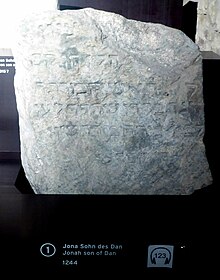Judenkiewer Spandau
The Judenkiewer Spandau is an old burial place of the Jewish residents of Spandau , it was first mentioned in 1324. The term "Kievan" is in all likelihood related to the Hebrew and Yiddish word קבר kejwer (grave).
It was a space made available to the Jews by the city of Spandau outside the city walls. They had to pay a price of one shock and 13 groschen to use it, as well as a funeral fee and a transit duty for their dead. The exact location of the burial site is now assumed to be a corridor called Hasenmark northwest of the old town of Spandau. For a long time - documented at least between 1436 and 1442 - the Spandau Judenkiewer also served Berlin Jews as a burial place.
In 1510 the Jews were expelled from the Mark Brandenburg and as a result the cemetery was also demolished. The tombstones were used between 1520 and 1533 when the Spandau Citadel was built . Many of these, for the most part, very massive stones were uncovered and recovered during construction work in the 20th century. In total, there are still around 70 stones and fragments from the years 1244 to 1474, which may come from several Spandau or Berlin cemeteries. The tombstone of Jonas, son of Dan, from 1244 is the oldest surviving Jewish tombstone in the whole of Brandenburg. Some of the stones can be seen in the archaeological window of the Spandau Citadel. Four of the stones are in the Jewish cemetery in Heerstrasse and two more in the Jewish Museum in Berlin-Kreuzberg .
literature
- Alfred Etzold, Joachim Fait, Peter Kirchner, Heinz Knobloch : The Jewish cemeteries in Berlin . Henschel Verlag Berlin 1991, ISBN 3-362-00557-8
- Michael Brocke : The Hebrew Jewish tombs in Spandau 1244-1474 . In: Excavations in Berlin. Research on prehistory and early history , Berlin 9 (1994) pp. 8–116 (66 stones and fragments, edited, translated and commented. With ill.)
- Jörn Roland Christophersen: Jewish cemeteries and cemetery districts in the late medieval Mark Brandenburg . In: Sigrid Hirbodian , Christian Jörg, Sabine Klapp and Jörg R. Müller (eds.): Pro multis beneficiis. Festschrift for Friedhelm Burgard. Research on the history of the Jews and the Trier area . Kliomedia, Trier 2012, pp. 129–146. ( Trier historical research 68), ISBN 978-3-89890-175-8
Individual evidence
- ↑ Joachim Pohl: The medieval Jewish gravestones and community facilities in the city of Spandau. In: Ashkenaz - magazine for the history and culture of the Jews. December 1, 2009, accessed May 24, 2011 .
- ^ Siegfried Moses: On the history of the cemetery and funeral system of the Jewish community in Berlin . In: Gemeindeblatt der Jüdischen Gemeinde zu Berlin , 8/1912, pp. 104–105 ( part 1 ); 11/1913, pp. 131-133 ( part 2 ); 8/1915, pp. 95–97 ( part 3 )
- ↑ Günter Stein : A castle building by Joachim I. Building history studies on the Spandau citadel . In: Yearbook for Brandenburg State History , Vol. 8 (1957), pp. 55–69, here p. 56.
- ↑ As suggested by Pohl (2009). Christophersen (2012), on the other hand, assumes a single Spandau cemetery that served as the central Jewish burial place for the Mittelmark.
Coordinates: 52 ° 32 ′ 28 " N , 13 ° 11 ′ 55" E

